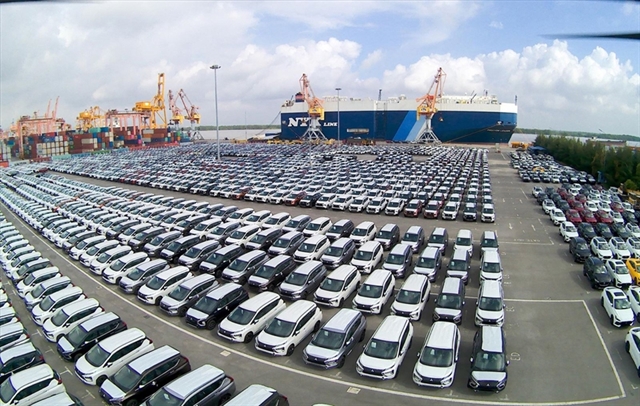This initiative aims to diversify the supply of imported vehicles, foster competition in the domestic market and align Việt Nam's tax policies with the evolving trends of the automotive industry.

HÀ NỘI — The Ministry of Finance is proposing adjustments to the Most-Favoured Nation (MFN) import tax rates on certain automobile models.
This initiative aims to diversify the supply of imported vehicles, foster competition in the domestic market, and align Việt Nam's tax policies with the evolving trends of the automotive industry.
Under the current regulations, cars classified under HS codes 8703.23.63, 8703.23.57, and 8703.24.51 are subject to relatively high MFN import tax rates.
HS code 8703.23.63 applies to passenger vehicles with a shared luggage compartment and sports utility vehicles (SUVs) with an engine capacity of over 2,000cc but not exceeding 2,500cc.
These vehicles currently face an MFN import tax rate of 64 per cent, while the WTO ceiling commitment is 70 per cent. HS code 8703.23.57 covers sedan-type vehicles with the same engine capacity range, also subject to an MFN tax rate of 64 per cent with a WTO ceiling of 70 per cent.
HS code 8703.24.51 includes four-wheel-drive vehicles, which are currently taxed at an MFN rate of 45 per cent, with a WTO ceiling of 47 per cent.
To improve market accessibility and enhance competition, the Ministry of Finance is proposing reductions in MFN import tax rates. The tax for vehicles under HS codes 8703.23.63 and 8703.23.57 would be reduced from 64 per cent to 32 per cent, aligning closely with Việt Nam’s CPTPP commitments for 2025. For HS code 8703.24.51, the rate would be lowered from 45 per cent to 32 per cent to ensure consistency across similar vehicle categories.
Việt Nam applies preferential tax rates for these vehicles under various free trade agreements (FTAs). For example, the ASEAN Trade in Goods Agreement (ATIGA) sets the import tax at 0 per cent, while other FTAs, including the Comprehensive and Progressive Agreement for Trans-Pacific Partnership (CPTPP), impose rates ranging from 25 per cent to 31.8 per cent.
Việt Nam's automobile market currently has an annual scale of approximately 510,000 vehicles, of which 338,000 are domestically manufactured and assembled, while 173,000 are imported, mainly from ASEAN countries enjoying a 0 per cent import tax under ATIGA. Compared to regional markets, Việt Nam’s automotive sector remains relatively small.
The Ministry of Industry and Trade projects that by 2030, annual car demand will reach 1 to 1.1 million units, meaning that the domestic industry must double its production capacity within the next five years to meet consumer needs.
Currently, domestic manufacturers focus primarily on vehicles with engine capacities below 2,000cc, which aligns with mainstream consumer preferences. In contrast, higher-capacity vehicles still rely heavily on imports due to the absence of suitable domestic production facilities.
The proposed tax reduction is expected to encourage market diversification by increasing the availability of premium and high-performance vehicles, balance tax policies with global trade trends, and make MFN-sourced vehicles more competitive against imports from ASEAN and other FTA partners.
According to the Ministry of Finance, implementing these tax reductions could result in an estimated revenue loss of US$8.81 million, based on 2024 import data. However, this shortfall may be offset by increased import volumes from MFN countries, replacing vehicles sourced from ASEAN.
The Ministry is currently gathering feedback from government agencies, industry stakeholders, and experts on the draft decree amending import tax rates under Decree No. 26/2023/NĐ-CP.
Once finalised, the proposed adjustments will be submitted to the Government for approval, with the revised tax policy expected to take effect from April. VNS





